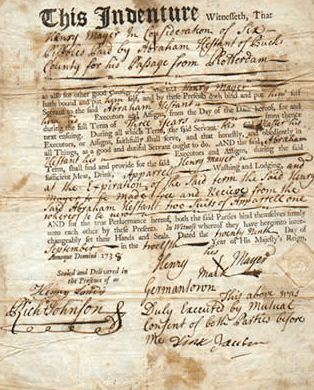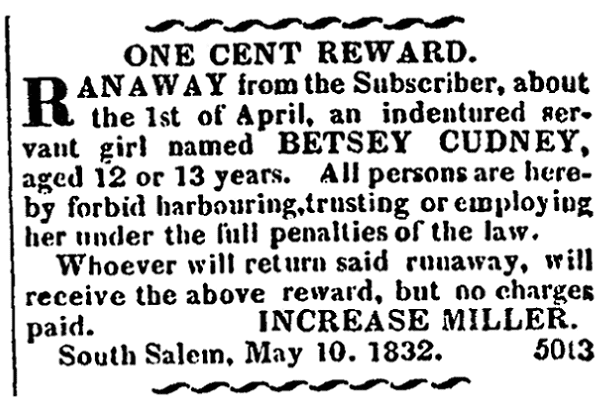Introduction: In this article, Mary Harrell-Sesniak writes about a source of family history information found in old newspapers that is often overlooked by genealogists: ads for runaway indentured servants. Mary is a genealogist, author and editor with a strong technology background.
Many of us have heard that our ancestors came to this country as indentured servants – but what does this mean?
It indicates that an agreement was made via contract. Usually the exchange was for free passage to a country in exchange for work performed for another individual for a certain length of time. In some cases, the contract was drawn up by a shipping company or officer and assigned to someone else upon arrival.

In the case of the all-too-frequent indentured child, a parent may have signed for a child who may or may not have had a say in the agreement. Unfortunately, it was common to take advantage of this situation, and many indentured servants were treated poorly – and some ran away. When this happened, advertisements were placed in local newspapers to recapture the indentured servant.
These old newspaper ads can be a real help to family historians, such as these examples found in GenealogyBank’s Historical Newspaper Archives.
Type of Information Posted
As you will see in the following examples, you can learn about rewards, personal descriptions, ethnicity, skills and relationships or relatives.
Descriptions
In this ad, 15-year-old Thomas Butler, who had run away from Jesse Ives Jr., was described as a well grown lad (fairly tall), dark complexion, black eyes and well dressed.
Alternative Keywords (Search Synonyms)
If you search for a specific keyword and notice another one worded differently, be sure to repeat the search.
In these two runaway ads, we see the use of “indentured servant” in one and “indentured apprentice” in the other. Search on both terms.
By using this concept, I located the below advertisement looking for Daniel Ferre who “skulk’d and sneak’d” away on the night of 30 June 1800 from Asher Bartlett.
Rewards
The rewards offered in these ads were the incentive for readers to participate in the capture and return of a runaway. In the early 1800s, many rewards were for a few cents – which certainly went much further back then than it does today.
Warnings
It was against the law to assist or shelter runaways. Note that in all three of these ads, the subscribers warned readers not to “trust” or “harbor” the runaway.
Ethnic Background
In this next ad, we learn that Charles Gibson was a mixed raced individual. He took with him three suits of clothes and a new drab-colored great coat, and was known to work on rough carpentry.
Relatives
Many runaways sought out those they knew, so we often learn an important piece of genealogical evidence in these runaway ads: relatives and residences. In the above ad, it was disclosed that Charles Gibson had a brother named Christopher who lived in the upper part of Caroline or on the edge of Queen Ann’s County.
Sample Indentures from the National Archives
If you’d like to examine how early indenture contracts were sometimes written, follow this link to the National Archives’ transcription of contracts written by Founding Fathers:
Indentured Servant Law
As with many topics of the past, be sure to acquaint yourself with laws and procedures of yesteryear. Indentured servant law changed over time:
- Slavery and Indentured Servants (Library of Congress)
Locating Individuals
It’s difficult to find other records regarding indentured servants and individuals, but perhaps these are some of the individuals mentioned in the above advertisements:
